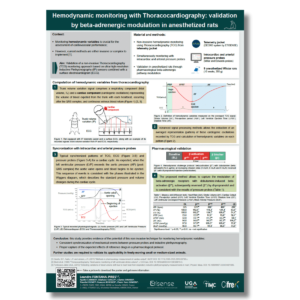Hemodynamic monitoring with thoracocardiography: Validation by beta-adrenergic modulation in anesthetized rats
Leandro Fontana Pires1,2, Agathe Cambier2, Stéphane Tanguy1, Charles Eynard2, Timothé Flenet2, Pierre-Yves Gumery1, François Boucher1
¹ PRETA TEAM, TIMC IMAG, 38706 La Tronche CEDEX, France;
² R&D, ETISENSE SAS, 69008 LYON, France
https://doi.org/10.1016/j.acvd.2024.05.027
Abstract
Hemodynamic monitoring is crucial for evaluating cardiovascular efficiency in both preclinical and clinical settings. However, currently available methods are either invasive or complex to implement in small animal models. Thoracocardiography (TCG) is a non-invasive approach that uses inductive plethysmography (IP) sensors to access cardiogenic oscillations. This can be achieved by using a telemetry jacket system (DECRO, ETISENSE) that embed ultra-high resolution IP sensors and surface electrodes for electrocardiogram (ECG) recording.
The study aimed to evaluate the implementation of this non-invasive approach and validate it through a hemodynamic challenge protocol in anesthetized rats.
Nine male Wistar rats (10 weeks old, 355 g) underwent a hemodynamic challenge protocol under 2%/2.5% isoflurane anesthesia and spontaneous ventilation. The protocol included baseline, modulation of the beta-adrenergic pathway with dobutamine (12.5 μg/mL, beta-stimulant) at ascending rates (4, 6 and 8 mL/h) and dl-propranolol (3 μmol/kg, beta-blocker, 1 mL/kg i.e.). Animals, equipped with the DECRO device, had pressure catheters in the left ventricle and left carotid artery. Heart rate (HR), stroke volume changes (SV), cardiac output (CO), left ventricular developed pressure (LVDP) and mean arterial pressure (MAP) were estimated using an averaging technique. The statistical tests used in the analysis were Friedman, Wilcoxon, and Pearson’s correlation.
Significant hemodynamic changes occurred during different phases compared to baseline. Dobutamine induced a positive inotropic and slight chronotropic effect at maximum dose compared to baseline (+7% HR, +40% SV, +49% CO and +14% LVDP; P < 0.001), while dl-Propranolol induced a negative inotropic and more pronounced chronotropic effect (−23% HR, −44% SV, −56% CO and −21% LVDP; P < 0.001). Positive correlations were found between SV and LVDP (0.68), and between CO and LVDP (0.77).
Significant differences between protocol phases were observed from both methods (pressure probes and TCG). TCG method effectively captured dobutamine and propranolol induced inotropic effects, providing evidence of its potential as a non-invasive approach for monitoring cardiovascular function through relevant hemodynamic variables.

